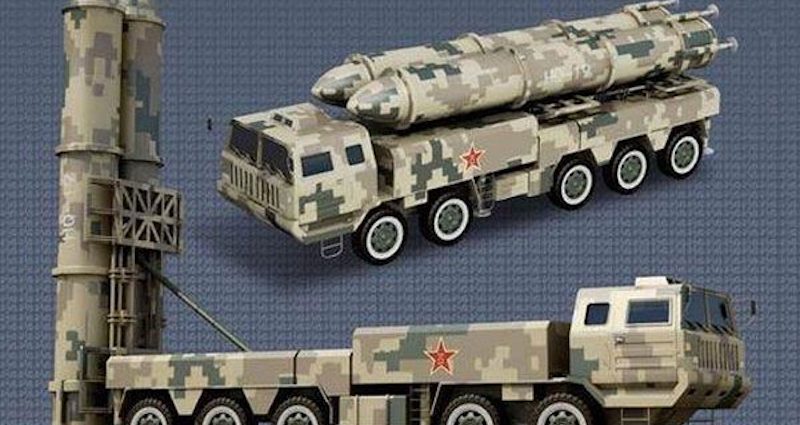
China has once again tested its mid-course missile interception capability, increasing the survivability of its land-based nuclear arsenal against nuclear threats from the US and India.
This month, the Associated Press reported that China’s Ministry of Defense (MoD) had announced it had carried out a successful mid-course missile interception test, showcasing its capability to bring down ballistic missiles from space.
A mid-course interception offers the most extended time window for a successful intercept. At that stage of flight, an incoming missile is no longer powered and follows a predictable ballistic arc upon re-entry to the atmosphere, allowing multiple interceptor missiles to be fired.
The source notes that the Chinese MoD said the test took place in Chinese territory and was not aimed at any other country, although it did not say whether the target was struck, how many interceptor missiles were fired, and where they landed.
In that test, China may have used its HQ-19 missile interceptor, which the Arms Control Association notes is similar to the US Terminal High Altitude Area Defense (THAAD), with the former system having a range of 1,000 to 3,000 kilometers, and designed for mid-course intercepts against intermediate-range ballistic missiles (IRBMs).
This was not the first time China had tested its missile defenses. Last October, Asia Times reported China’s successful land-based mid-course interception test, with the Chinese MoD emphasizing that it was defensive and not aimed at any country.
Despite that innocuous statement, the test demonstrates the capabilities of China’s missile defenses against US intercontinental ballistic missiles (ICBMs) and IRBMs in the Pacific.
The test may also align with China’s efforts to increase the survivability of its land-based nuclear arsenal, which may act as a “missile sponge” to draw incoming missiles away from populated areas and force an adversary to launch more missiles for a successful attack. Also, China’s land-based arsenal assures of it a first-strike capability, despite its long-standing “no first use” policy.
Given that, China’s October missile interception tests also align with its efforts to enhance the survivability of its nuclear arsenal, now more critical in the time of great-power competition with the US and rising tensions in the Taiwan Strait.
Asia Times noted last month that China, possibly with Russia’s help, aims to enlarge its nuclear arsenal from 400 warheads now to 1,500 by 2035, with 700 warheads being enough for China to have secure second-strike capability, conduct limited theater strikes, and put it in a better position to brandish nuclear weapons coercively.
China’s efforts to enlarge its nuclear arsenal and improve its survivability may also be in response to US and Indian improvements to their nuclear deterrents.
This month, Asia Times reported on the US introduction of the Next Generation Re-entry Vehicle (NGRV), which features increased survivability, lethality, and accuracy. The NGRV also features a modular design and open architecture, allowing the incorporation of future warhead designs that feature increased accuracy and effectiveness against hardened targets such as land-based missile silos.
In connection with that, last April, Asia Times reported on US plans to induct the LGM-35A Sentinel to replace the long-serving LGM-30G Minuteman III as the foundation of its land-based nuclear deterrent.
As with the NGRV, the LGM-35A Sentinel features a modular design and open architecture, allowing for the easy replacement of aging and obsolete components and integrating new safety measures, guidance systems, and missile penetration aids.
Most tellingly, the LGM-35A Sentinel features improved throw weight compared with the LGM-30G Minuteman III, allowing it to carry heavier payloads and increasing its mission flexibility. The LGM-35A Sentinel can carry up to three warheads or increased penetration aids.
China may be building its missile defenses against India apart from the US. Last August, Asia Times reported on India’s successful test of a submarine-launched ballistic missile (SLBM) from the INS Arihant nuclear ballistic missile submarine (SSBN). Most likely, India used its Sagarika SLBM during the test, which has a relatively short range of 700km and can carry a 1-ton warhead.
That means India’s SSBN fleet has to maneuver close to enemy waters to launch its missiles, which exposes them to enemy attack and negates the logic of having an SSBN. Cognizant of the Sagarika’s short range, India tested the K-4 SLBM in 2020, which sports a 3,500km range in a possible effort to address the shortcomings of its sea-based nuclear deterrent.
In addition, India has already taken steps to establish a strategic rocket force amid renewed border tensions with China and possibly a failing deterrent posture. Last December, Asia Times reported that India had begun the construction of underground missile bases in its border states with China.
These bases are intended to keep India’s missile arsenal safe from pre-emptive attacks and allow it to mount a quick counterstrike. In addition, India might soon acquire up to 120 Pralay short-range ballistic missiles (SRBM) with a range of 150-500km for use against Chinese troop concentrations along the Line of Actual Control (LAC) between the two countries.
However, India has a low rate of ballistic-missile production, still relying on the 1980s-vintage Prithvi SRBM as its main tactical ballistic missile. India has yet to fully adopt road-mobile ballistic missiles, with limited stocks of the Shaurya and Prahaar missiles.
While India has the supersonic Brahmos cruise missile, that weapon may be too expensive to be deployed in large numbers.
Given that, Hsiao-Huang Shu notes in a 2021 report for the Institute of National Defense and Security Research, a Taiwan-based think-tank, that China’s successful anti-ballistic-missile tests show that it is close to accomplishing its goals for its missile defense system, which aims to counter US deployments of medium-range weapons in the Pacific, and offsets the threat of an Indian nuclear strike.
Shu says the United States’ slow development of medium-range weapons, the reluctance of its Asian allies to host such weapons, and the repeated failures of its hypersonic weapons program mean that China is unlikely to be intimidated soon. Because of that, he says China’s anti-missile defenses should be able to counter US missile threats effectively.

